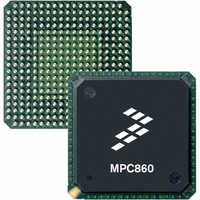MC68360VR25VL Freescale Semiconductor, MC68360VR25VL Datasheet - Page 261

MC68360VR25VL
Manufacturer Part Number
MC68360VR25VL
Description
IC MPU QUICC 25MHZ 357-PBGA
Manufacturer
Freescale Semiconductor
Datasheets
1.MC68EN360VR25L.pdf
(14 pages)
2.MC68EN360VR25L.pdf
(2 pages)
3.MC68360AI25L.pdf
(962 pages)
Specifications of MC68360VR25VL
Processor Type
M683xx 32-Bit
Speed
25MHz
Voltage
3.3V
Mounting Type
Surface Mount
Package / Case
357-PBGA
Family Name
M68000
Device Core
ColdFire
Device Core Size
32b
Frequency (max)
25MHz
Instruction Set Architecture
RISC
Operating Supply Voltage (max)
3.3V
Operating Supply Voltage (min)
2.7V
Operating Temp Range
0C to 70C
Operating Temperature Classification
Commercial
Mounting
Surface Mount
Pin Count
357
Package Type
BGA
Lead Free Status / RoHS Status
Lead free / RoHS Compliant
Features
-
Lead Free Status / Rohs Status
Compliant
Available stocks
Company
Part Number
Manufacturer
Quantity
Price
Company:
Part Number:
MC68360VR25VL
Manufacturer:
Exar
Quantity:
160
Company:
Part Number:
MC68360VR25VL
Manufacturer:
Freescale Semiconductor
Quantity:
10 000
Company:
Part Number:
MC68360VR25VLR2
Manufacturer:
Freescale Semiconductor
Quantity:
10 000
- Current page: 261 of 962
- Download datasheet (4Mb)
The general system clock can switch automatically from low to high frequency whenever
one of the following conditions exists:
When neither of these conditions exists, the general system clock automatically switches
back to the low frequency.
When the general system clock is divided, its duty cycle is changed. One phase remains the
same (e.g., 20 ns @ 25 MHz); the other becomes longer. Note that the CLKO1 and CLKO2
pins no longer have a 50% duty cycle when the general system clock is divided (see Figure
6-8).
6.5.5.3 BRGCLK. The BRGCLK is used by the five CPM baud rate generators. There are
four SCC/SCM baud rate generators and one SPI baud rate generator. BRGCLK defaults
to VCO/2 = 25 MHz (assuming a 25-MHz system frequency). The purpose of BRGCLK is to
allow the five baud rate generators to continue to operate at a fixed frequency, even when
the rest of the QUICC is operating at a reduced frequency (i.e., the general system clock is
divided). See 7.9 Baud Rate Generators (BRGs) for more information on how to save power
using the BRGCLK.
6.5.5.4 SYNCCLK. The SyncCLK is used by the serial synchronization circuitry in the serial
ports of the CPM, including the SI, SCCs, and SMCs. The SyncCLK performs the function
of synchronizing externally generated clocks before they are used internally. SyncCLK
defaults to VCO/2 = 25 MHz (assuming a 25-MHz system frequency).
The purpose of SyncCLK is to allow the SI, SCCs, and SMCs to continue to operate at a
fixed frequency, even when the rest of the QUICC is operating at a reduced frequency.
Thus, SyncCLK allows the user to maintain the serial synchronization circuitry at the desired
rate, while lowering the general system clock to the lowest possible rate. However, the Sync-
CLK frequency must always be at least as high as the general system clock frequency.
• The level of the pending or current interrupt is higher than the INTEN bits in CDVCR.
• The CPM RISC controller has a pending request or is currently executing a routine (i.e.,
it is not idle). This option is maskable by the RRQEN bit in CDVCR.
During early board prototyping, the user should leave BRGCLK
at its standard frequency (e.g., 25 MHz) for the sake of simplici-
ty.
Within the four SCC/SMC baud rate generators, the user should
not use a baud rate generator divider equal to 1, unless the
BRGCLK is at the maximum frequency.
DIVIDE BY 1
DIVIDE BY 2
DIVIDE BY 4
Freescale Semiconductor, Inc.
For More Information On This Product,
Figure 6-8. Divided Clocks
MC68360 USER’S MANUAL
Go to: www.freescale.com
NOTES
System Integration Module (SIM60)
Related parts for MC68360VR25VL
Image
Part Number
Description
Manufacturer
Datasheet
Request
R
Part Number:
Description:
Manufacturer:
Freescale Semiconductor, Inc
Datasheet:

Part Number:
Description:
MC68360 MC68360 Multiple Ethernet Channels on the QUICC
Manufacturer:
Motorola / Freescale Semiconductor

Part Number:
Description:
MC68360 Implementing an 8 bit Eprom for an MC68EC040-MC68360 System
Manufacturer:
Motorola / Freescale Semiconductor

Part Number:
Description:
MC68360 Interfacing the MC68060 to the MC68360
Manufacturer:
Motorola / Freescale Semiconductor

Part Number:
Description:
MC68360 MC68360 RAM Microcode Package Option Overview
Manufacturer:
Motorola / Freescale Semiconductor

Part Number:
Description:
MC68360 MC68360 CPM-CPU Interaction
Manufacturer:
Motorola / Freescale Semiconductor

Part Number:
Description:
MC68360 Interfacing SDRAM to the MC68360 QUICC Device
Manufacturer:
Motorola / Freescale Semiconductor

Part Number:
Description:
MC68360 Interfacing the QUICC to a MCM516400 (4Mx4 10-12 column-row) DRAM
Manufacturer:
Motorola / Freescale Semiconductor

Part Number:
Description:
MC68360 Interfacing the 68360 (QUICC) to T1-E1 Systems
Manufacturer:
Motorola / Freescale Semiconductor

Part Number:
Description:
MC68360 Multiple QUICC Design Concept
Manufacturer:
Motorola / Freescale Semiconductor
Part Number:
Description:
Manufacturer:
Freescale Semiconductor, Inc
Datasheet:
Part Number:
Description:
Manufacturer:
Freescale Semiconductor, Inc
Datasheet:
Part Number:
Description:
Manufacturer:
Freescale Semiconductor, Inc
Datasheet:
Part Number:
Description:
Manufacturer:
Freescale Semiconductor, Inc
Datasheet:
Part Number:
Description:
Manufacturer:
Freescale Semiconductor, Inc
Datasheet:











